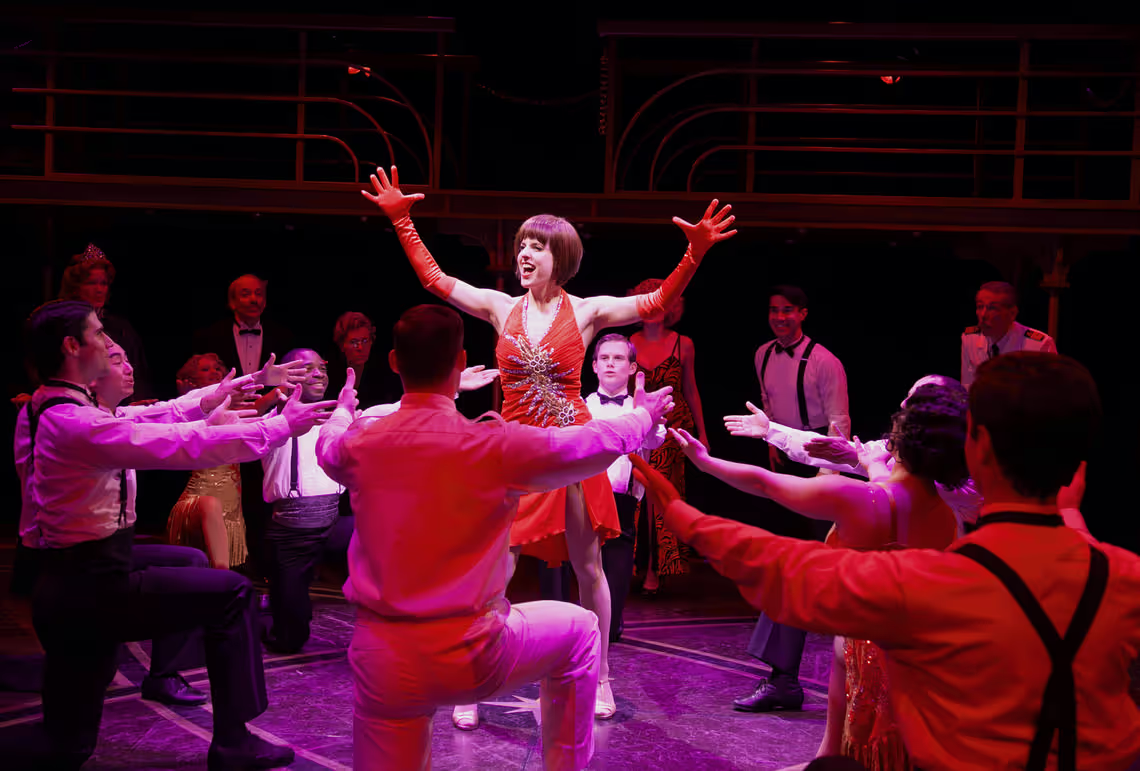'Anything Goes' at the Marriott Theatre
Cole Porter’s “Anything Goes” was a major musical success in 1934. Like all musical comedy hits of the 1920’s and 1930’s, the story is twaddle but the songs are great and there are opportunities for high stepping dancing. The show was revived, with alterations, in 1987 and 2011. Now the Marriott Theatre is staging “Anything Goes” (in the 1987 edition). The story is still twaddle, but agreeably so, and the music and dancing are a joy.
The revival retains original Cole Porter hits like “I Get a Kick Out of You,” “You’re the Top,” “Blow, Gabriel, Blow,” and “All Through the Night,” and plugs in Porter classics from elsewhere, like “Easy to Love,” “Friendship,” and “It’s De-Lovely.” The numbers are embedded in a story that takes place on a trans Atlantic ocean liner and concerns itself with assorted love affairs and comic misadventures. After the usual confusions and false starts, all the relevant characters on stage are paired off appropriately, if improbably, in time for the entire ensemble to sing and dance exuberantly into the night.
The show’s core character is a jazz baby evangelist named Reno Sweeney, played by Ethel Merman in 1934, Patty LuPone in 1987, and Sutton Foster in 2011. At Marriott, the role belongs to Stephanie Binetti, she of the long legs and belting voice.
Capitalizing on the nonsensical book, the non-musical stage time is dominated by the comic actors, and Marriott is employing two of the best we have in Ross Lehman and Gene Weygandt. Lehman has been making local audiences chuckle seemingly since the presidency of William Henry Harrison. He’s a master of very broad comedy and he is thoroughly at home playing Moonface Martin, an ineffectual gangster ranked public enemy number #13 by the FBI and a man yearning to reach the magical public enemy #1 plateau. Lehman lays on the shtick with a prodigal hand, both physically and vocally, even leading the ensemble in a musical number like a mad orchestra conductor. I am not a huge fan of silly comedy on stage but if I have to watch it, I want Lehman to do the honors. Weygandt does the nearly impossible, making a drunk, and an impossibly nearsighted one at that, seem legitimately funny.
The romance comes from the quartet of Reno Sweeney, a young stockbroker named Billy Crocker (Jameson Cooper), a debutante named Hope Harcourt (Summer Naomi Smart), and a silly ass British aristocrat named Lord Evelyn Oakleigh (Patrick Lane). They are all aligned improperly at the beginning but by the last scene there is carnage of weddings, not only among the four principals but also between Hope’s mother (Mary Ernster) and the rich drunk (Weygandt). A ditzy oversexed blonde named Emma (Alexandra Palkovic) apparently wins the entire ship’s crew for her romantic convenience.
Director-choreographer Marc Robin recognizes that he is not staging “A Little Night Music.” He allows the farcical comedy to run free, and if there are a few over the top moments, that’s the price of doing business with this kind of vehicle. And with the main comedy in the hands of Lehman and Weygandt, the narrative chaos works very nicely. Plus, deft comic touches and witty lines have been inserted throughout the book, first by P. G. Wodehouse and Guy Bolton and later by Howard Lindsay and Russel Crouse. Best of all are the scintillating Cole Porter lyrics, especially the “catalogue” songs like “You’re the Top” with their endless stream of verbal invention.
The production numbers come late at the Marriott, the first not taking over the stage until the first act finale. Until then the audience had to be content with a couple of Fred and Ginger romantic duets by Smart and Jameson. But the second act set the opening night audience whooping with glee with the exhilarating song and dance forays into “Public Enemy #1,” “Blow, Gabriel Blow,” and the all hands on deck finale.
The ensemble runs to almost two dozen performers, including those old pros Ernster as Hope Harcourt’s fortunate hunting mother and John Reeger as the ship’s captain. Anne Gunn even gets in a few zingers as an old lady in a wheelchair. The eager young chorus is all high energy, typified by Sayiga Eugene Peabody’s back flips. The chorus is also responsible for making complicated changes on a nearly dark stage between scenes, executed deftly and mostly silently.
Robin brings the show in at a tight 2 hours and 15 minutes. His staging is assisted heroically by the stunning 1930’s wardrobe designed by Nancy Missimi for the female characters. Missimi’s costumes never disappoint, but in this show she has outdone herself in glitz and glamour and variety. Marriott has obviously given her a blank check and she has spent every dollar imaginatively. I’m sure the ladies of the cast are dying to take those outfits home with them after the show closes. The rest of the physical production resides in the capable hands of Thomas M. Ryan (sets), Jesse Klug (lighting), Robert Gilmartin (sound), and Sally Weiss (properties design). Patti Garwood conducts the capable offstage orchestra.
“Anything Goes” treats the inanities of its storyline and characters with genial high spirits. The audience certainly will show tolerance for the antics on stage because the glorious songs maintain some dignity in Hope-Evelyn love affair, and Jameson Lane tosses off the stereotyped English booby with great élan. Lehman and Weygandt take care of the slapstick comic business to unanimous audience satisfaction. There are a few double entendres, none exceeding the PG-13 level. The success of reconstituted musicals like “Anything Goes,” “My One and Only,” and “Crazy for You” demonstrate the public’s ongoing love for the American songbook, with its hummable melodies and sharp lyrics in the service of a total fun evening. And so it is at the Marriott.











